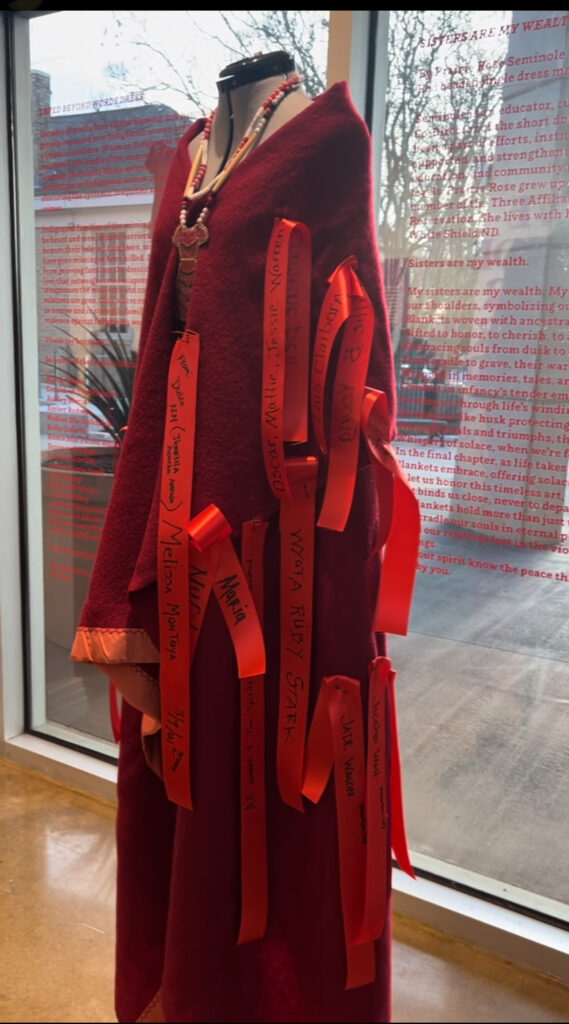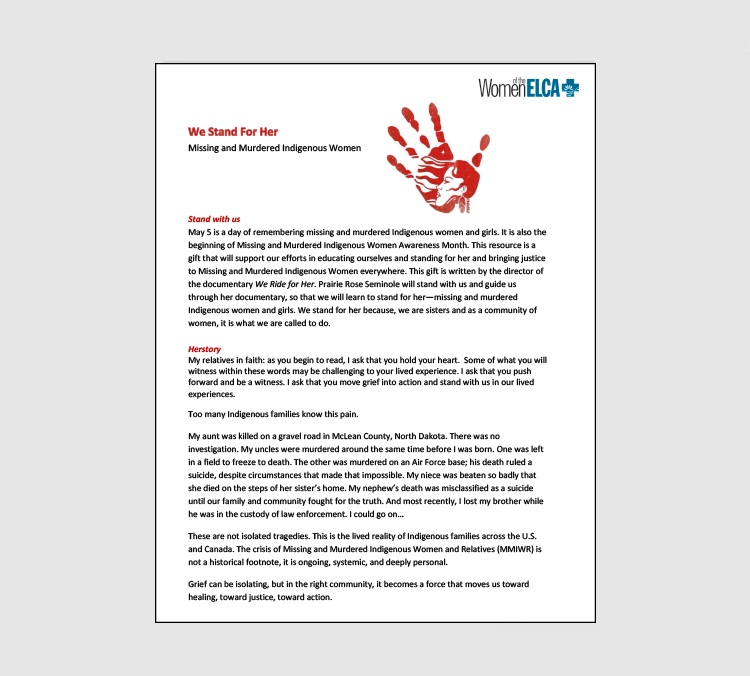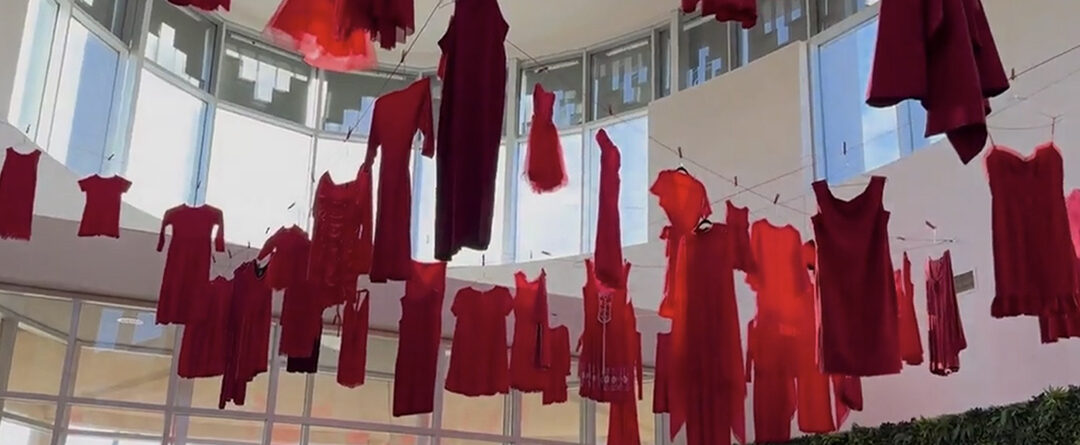by Prairie Rose Seminole
The red dress has become a powerful symbol of remembrance, resilience, and justice for Missing and Murdered Indigenous Relatives (MMIR). Across North America, Indigenous communities and allies gather to wear red, hang red dresses in public spaces, and speak the names of those who have been taken. This act of remembrance is more than symbolic; it is a call to action, a way to honor the lives lost, and a means to amplify the voices of those fighting for justice.
As an Indigenous woman, and even in our Lutheran way, we understand that stories carry power. They are not just words on a page; they live in us, shaping our understanding of the world and our responsibilities to one another. The story of Missing and Murdered Indigenous Women (MMIW) and Relatives is one of deep loss, one that my own family knows too well.
We have buried too many, grieved too deeply, and carried the weight of justice systems that do not protect us. It isn’t easy to fight the design. It took intention to create the systems we are in. The government and the policies toward Indigenous people in this country were designed so that every human failure happens.
Education? We were forced away from our systems to one that taught us we had no value unless we were white.
Justice? No comfort in the justice system. Even today, our men are killed by law enforcement at a higher rate than any other demographic, and our women are missing at the highest rates with little law enforcement intervention in their search.
Friendship? Through assimilative educational and social systems, we have been pitted against one another to see the highest rates of lateral oppression. Isolating and teaching a false meritocracy by giving some more and others less, challenging our value systems altogether, and creating systems of scarcity that we buy into.
Family? Removal and family separation was legal for over 150 years through boarding school policies where our parents were fined or jailed if they didn’t give our children up. What do you think separation and isolation do to an individual and communities? Trauma over generations. Family and kinship systems decimated.
What happened, you don’t just forget about it. It matters because it never ended.
We are here by design, still reeling from the effects of colonial violence that includes lateral oppression, a form of bullying that occurs within the same marginalized group.
We can end these cycles, which is not easy and will not happen without intentionality. For those who choose to read on, I ask that you care for your spirit in this sacred space of truth-telling.
In the teachings of my people, grief is not meant to be held alone; it is meant to be shared and carried together in a community. And yet, grief alone is not enough. As people of faith, we are called to act, to walk alongside those who suffer, and to challenge the injustices that allow this crisis to continue.
Lutheran teachings speak of justice and mercy, of lifting up the brokenhearted and standing with the oppressed. But what does that mean when Indigenous women, girls, Two-Spirit, individuals who have both masculine and feminine spirits, and relatives continue to go missing and are murdered at alarming rates?
It means that faith must move beyond words. It must be lived out in advocacy, in demanding better from the systems that continue to fail Indigenous peoples, and in ensuring that these stories are not forgotten.
As you sit with this reality, I ask you to do more than grieve and lament. I ask you to listen, to learn, and to act because to love your neighbor as yourself means fighting for a world where they are safe, where they are seen, and where they are not stolen from their families and communities.
Seeing the Unseen: Why We Wear Red
 Among many Indigenous traditions, the color red holds profound spiritual significance. For some Indigenous peoples like my own, it is believed that red is the only color spirits can see, and by wearing red, we make ourselves visible to those who have been taken. In ceremonies and gatherings dedicated to MMIR, the presence of red becomes a beacon, calling the spirits of our loved ones home, ensuring they are not forgotten, and guiding them back into our collective memory.
Among many Indigenous traditions, the color red holds profound spiritual significance. For some Indigenous peoples like my own, it is believed that red is the only color spirits can see, and by wearing red, we make ourselves visible to those who have been taken. In ceremonies and gatherings dedicated to MMIR, the presence of red becomes a beacon, calling the spirits of our loved ones home, ensuring they are not forgotten, and guiding them back into our collective memory.
The REDress Project was initiated by Métis artist Jaime Black in 2010. Her installation of empty red dresses in public spaces was a striking visual representation of the thousands of Indigenous women, girls, and Two-Spirit people who have gone missing or been murdered. Since then, the red dress has grown into a movement, a way for communities to express grief, demand accountability, and stand in solidarity.
The Crisis of MMIR
The crisis of Missing and Murdered Indigenous Relatives is deeply rooted in colonial violence, systemic racism, and ongoing injustices. Indigenous women are disproportionately affected by violence, with homicide rates far exceeding those of non-Indigenous women. The lack of proper investigations, media coverage, and government action has led families and communities to take matters into their own hands, forming search parties, marching, organizing, establishing mutual aid networks and writing policy, refusing to let these lives be erased. Murder is the third leading cause of death for Indigenous women in the United States. THIRD.
For me, this movement isn’t political; it’s personal. I’m at risk just being an Indigenous woman. My aunt was killed on a gravel road in McLean County, ND. No investigation. My uncles were murdered around the same time; one was left to freeze to death in a field, the other murdered on an Air Force base; his death ruled a suicide, though the circumstances made that impossible. My niece was beaten so badly that she died on the steps of her sister’s home. My nephew’s death was misclassified as a suicide until our family and community fought for the truth. And most recently, I lost my brother while he was in the custody of law enforcement. I could go on.
Too many Indigenous families know this pain.
Grief can be isolating, but in the right community, it can be a force that moves us toward healing and action.
Wearing red and displaying red dresses is an act of defiance against this erasure. It is a way of saying, “We see you. We remember you. We will not stop fighting for you.” The red dress movement is about reclaiming space, asserting Indigenous presence, and demanding that those in power address the ongoing crisis with urgency and respect.
 How to Show Support and Take Action
How to Show Support and Take Action
1. Educate Yourself and Others – Learn about the history of MMIR, the policies that contributed to the crisis, and the stories of those affected. Share this knowledge with your communities.
2. Participate in Red Dress Events – Attend local vigils, awareness walks, and installations. Wearing red on May 5th, the National Day of Awareness for MMIR, is a powerful way to show solidarity.
3. Support Indigenous-led Organizations – Donate to or volunteer with groups that provide resources, advocacy, and support to Indigenous families seeking justice.
4. Advocate for Policy Changes – Contact lawmakers, demand action, and support legislative efforts aimed at addressing violence against Indigenous peoples.
5. Listen to Indigenous Voices – Center Indigenous perspectives in conversations about MMIR and respect the lived experiences of those directly impacted.
Discussion Questions
- What does the red dress symbolize for you, and how can its meaning be applied to other forms of justice work?
- How can allies move beyond symbolic gestures to actively support Indigenous communities in addressing MMIR?
- What systemic changes need to take place to ensure Indigenous women, girls, and Two-Spirit people are protected and valued?
Closing Prayer
Creator, hear our voices. We gather with heavy hearts, calling out for justice, for truth, for the return of all missing and murdered relatives. Too many have been taken, and too many of us have looked away. We ask you to stir the hearts of those who have ignored the cries, to unsettle the ones who benefit from silence, and to call all people into the sacred work of reckoning.
Hold us in the weight of this grief, but do not let us stay there. Give us the courage to face the truth of stolen lives, broken systems, and a world that has long deemed people expendable. Let this truth break open what must be broken so that something just and whole can be built in its place.
May the red we wear be more than a symbol. May it be a mirror, forcing reflection. May it be a wound, demanding lament. May it be a fire, igniting action. Let it burn away indifference and call forth transformation.
The red dress is more than fabric—it is an indictment, a prayer, and a promise. We will not stop speaking the names of those taken. We will not stop demanding justice from systems built to erase us. We will not stop until every relative is accounted for until every loss is acknowledged until every life is honored.
Creator, move us beyond words and into action. Let accountability be our offering. Let truth-telling be our worship. Let justice be the path we walk until every stolen relative is home. Amen.
 Prairie Rose Seminole is an enrolled member of the MHA Nation of North Dakota and a dedicated advocate for Indigenous rights, cultural preservation, and storytelling. With years of experience building relationships in Indigenous communities, Prairie Rose has worked at the intersection of advocacy, arts, and healing. They were the former Program Director of the American Indian Alaska Native Ministries with the ELCA. They serve on the boards of Humanities ND, Gender Justice U.S., Olamina Fund and the Midwest Innocence Project. Their latest project, We Ride for Her, a documentary short on missing and murdered Indigenous relatives—draws on deep, trusted relationships built over three years with Indigenous motorcyclists, shedding light on the crisis through their lived experiences.
Prairie Rose Seminole is an enrolled member of the MHA Nation of North Dakota and a dedicated advocate for Indigenous rights, cultural preservation, and storytelling. With years of experience building relationships in Indigenous communities, Prairie Rose has worked at the intersection of advocacy, arts, and healing. They were the former Program Director of the American Indian Alaska Native Ministries with the ELCA. They serve on the boards of Humanities ND, Gender Justice U.S., Olamina Fund and the Midwest Innocence Project. Their latest project, We Ride for Her, a documentary short on missing and murdered Indigenous relatives—draws on deep, trusted relationships built over three years with Indigenous motorcyclists, shedding light on the crisis through their lived experiences.
She and Wanda will be working on a Lenten Devotional for 2026 season. Keep an eye out for that.


I am not of indigenous background, but my roommate is. Indigenous people have long been treated as second-rate citizens. Right now I am following the disappearance and murder of a 13 year old young woman in Arizona. So far there is no suspect. Nothing has been said about possible DNA. My roommate is certain the perpetrator is white. We shall see if anyone is ever arrested.
This is such a great way to remember and to raise an alert among people of faith how the doctrine of discovery continues to create havoc and misery among the indigenous community. I wonder if you have a liturgy/order of worship prepared for the day of remembrance for those who would like to raise Red Dress in the church in solidarity with Indigenous women and girls. Thank you.
I appreciate the information. My great grandmother was 1/2 Seminole but I do not have very much information. I will mark my calendar for Red Dress day May 5 yearly.